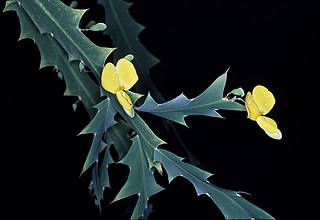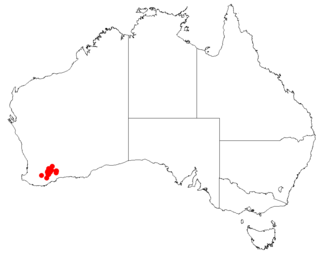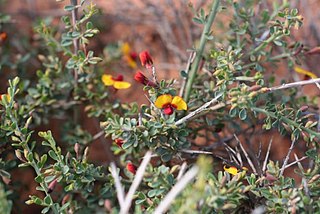
Bossiaea walkeri, commonly known as cactus bossiaea, cactus pea, or Walker's stick bush is a species of flowering plant in the pea family (Fabaceae) and is endemic to southern mainland Australia. It is a rigid, much-branched shrub with flattened, winged cladodes and red, pea-like flowers between July and November in the species' native range.
Bossiaea vombata, commonly known as wombat bossiaea, is a species of flowering plant in the family Fabaceae and is endemic to the Wombat State Forest in Victoria, Australia. It is an erect shrub with flattened cladodes and yellow, pea-like flowers.

Bossiaea bossiaeoides is a species of flowering plant in the family Fabaceae and is endemic to northern Australia. It is much-branched, glabrous shrub with broadly winged stems, winged and lobed cladodes, leaves reduced to small scales, and yellow flowers, sometimes with orange or red blotches.

Bossiaea halophila is a species of flowering plant in the family Fabaceae and is endemic to Western Australia. It is a dense, erect, many-branched shrub with narrow-winged cladodes, leaves reduced to small scales, and yellow-orange and deep red flowers.
Goodenia psammophila is a species of flowering plant in the family Goodeniaceae and endemic to the Kimberley region of Western Australia. It is a prostrate or erect annual herb with narrow lance-shaped to egg-shaped leaves with the narrower end towards the base, and racemes of yellow flowers with brownish or whitish lobes.
Bossiaea arcuata is a species of flowering plant in the family Fabaceae and is endemic to a small area in Western Australia. It is an erect, openly-branched, more or less leafless shrub with often arched cladodes, and yellow and red pea-like flowers.
Bossiaea arenitensis , commonly known as sandstone winged pea, is a species of flowering plant in the pea family Fabaceae and is endemic to the Kimberley region of Western Australia. It is an erect, spindly shrub with winged stems, winged cladodes, scale-like leaves and yellow, red and burgundy-coloured flowers.
Bossiaea barrettiorum is a species of flowering plant in the family Fabaceae and is endemic to a restricted area in the Northern Kimberley region of Western Australia. It is low, spreading or prostrate shrub with winged stems, winged cladodes, leaves reduced to small scales, and deep yellow and red flowers.

Bossiaea calcicola is a species of flowering plant in the family Fabaceae and is endemic to the far west of Western Australia. It is compact, glaucous, spiny shrub with oblong, wedge-shaped or round leaves and bright yellow, reddish and greenish-yellow flowers.
Bossiaea celata is a species of flowering plant in the family Fabaceae and is endemic to Western Australia. It is a compact, many-branched shrub with flattened cladodes, leaves reduced to scales, and yellow to pinkish-red pea-like flowers.
Bossiaea cucullata is a species of flowering plant in the family Fabaceae and is endemic to Western Australia. It is a dense, many-branched shrub with narrow-winged cladodes, leaves reduced to dark brown scales, and yellow and deep red or pale greenish-yellow flowers.
Bossiaea flexuosa is a species of flowering plant in the family Fabaceae and is endemic to Western Australia. It is a compact shrub with slightly flattened, zigzag branches, notched, more or less leafless cladodes, and golden yellow and red or pinkish flowers.

Pultenaea fragrans is a species of flowering plant in the family Fabaceae and is endemic to a small area of New South Wales. It is an erect shrub with flattened cladodes, small, scale-like leaves, and pea-like, yellow and red flowers.

Pultenaea grayi, commonly known as Murrumbidgee bossiaea, is a species of flowering plant in the family Fabaceae and is endemic to the Australian Capital Territory. It is an erect shrub with flattened, winged, glabrous cladodes, leaves reduced to small scales, and pea-like, yellow and red flowers.
Bossiaea inundata is a species of flowering plant in the family Fabaceae and is endemic to the Murchison River Gorge in Western Australia. It is a spreading, openly-branched shrub with oblong, elliptic or egg-shaped leaves with the narrower end towards the base, and deep yellow and red flowers.

Bossiaea ornata, commonly known as broad leaved brown pea, is a species of flowering plant in the family Fabaceae and is endemic to the south-west of Western Australia. It is a shrub with variably-shaped leaves, typically egg-shaped or oblong, and yellow or orange-yellow and reddish-brown flowers.
Bossiaea praetermissa is a species of flowering plant in the family Fabaceae and is endemic to near-coastal areas in the far south-west of Western Australia. It is a shrub with many flattened, winged cladodes and deep yellow and reddish or maroon flowers.

Bossiaea rufa is a species of flowering plant in the family Fabaceae and is endemic to the south-west of Western Australia. It is a loose, many-branched shrub with elliptic to egg-shaped leaves with the narrower end towards the base, and deep yellow and red flowers.
Bossiaea saxosa is a species of flowering plant in the family Fabaceae and is endemic to a restricted area near Norseman, Western Australia. It is an erect, intricately branched shrub with many slightly flattened, sharply-pointed cladodes and deep yellow, red and lemon-yellow, pea-like flowers.
Bossiaea simulata is a species of flowering plant in the family Fabaceae and is endemic to inland areas of Western Australia. It is a compact shrub with sharply-pointed cladodes and yellow, pea-like flowers sometimes with red markings.








